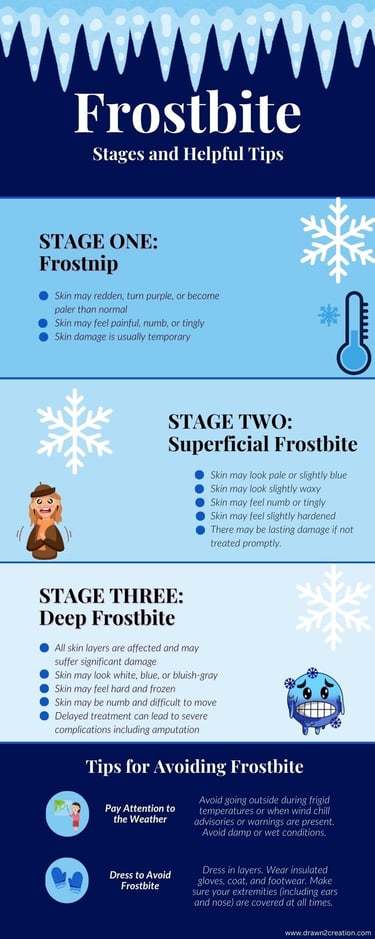Identifying Frostbite Symptoms & Treatment
Learn how to identify frostbite symptoms and understand the stages of frostbite. Discover effective frostbite treatment methods and essential tips for cold weather safety to protect yourself during winter outdoor activities.
OUTDOOR TIPS
12/14/20246 min read


What is Frostbite?
Frostbite occurs when skin is exposed to extremely low temperatures and the skin and underlying tissues freeze. This happens because our body tends to constrict blood flow when exposed to cold temps in an effort to retain heat. Our blood vessels constrict a bit, and blood flow to outer extremities (like fingers, toes, and ears) gets reduced. Our body wants to keep the blood (and heat) around our vital organs. That's great for staying alive and all...but we want to keep those extremities safe too! If the extremities are exposed to cold temperatures for too long, and that blood flow remains constricted, irreversible damage can occur.
Frostbite can even occur underneath winter clothing, and recognizing the symptoms of frostbite early is crucial for preventing serious injury. The initial symptoms typically include redness, tingling, or coldness in the affected areas. As the condition worsens, the skin may become hard, waxy, and discolored, often looking white, gray, or blue. Severe cases, if not treated quickly, can lead to complications such as infections, gangrene, or even amputation of the frostbitten extremities. Therefore, it is essential to look for and pay attention to frostbite symptoms when out in the cold weather, and to seek prompt medical attention if frostbite is suspected.
All about Frostbite
Well, it is that time of year again. Time when the outside temperatures drop, the wind picks up, and you may find yourself wondering why you live in an area that is colder than your freezer! Winter weather can be brutal, and there are definitely some precautions to be taken when you are getting some fresh air in the frosty temps. This post is all about frostbite: the stages of frostbite, what to do if frostbite is suspected, and how to avoid it in the first place.
Stages of Frostbite
Frostbite damage has stages, much like burns have stages. Each stage refers to a different level of skin and tissue damage. It is important to know and recognize these stages because it will help you to treat the frostbite in the most effective and safe manner.
Stage 1: Frostnip
This stage of frostbite is generally pretty mild. Skin will redden, become purplish, or even pale in comparison to your normal skin tone. The affected skin will feel either painful or numb. Some people report a tingling sensation as well. The skin will feel very cold and perhaps stiff. The good news is that skin damage from frost nip is typically temporary and will not cause permanent damage.
How to Treat Frostnip:
Get inside and out of the cold weather immediately. Remove any wet clothing.
Slowly warm your skin by putting it under warm water. Do NOT use hot water as this can lead to burns because your skin may not be sensing temperatures correctly at this point. Do NOT apply direct heat (like from a heating pad or heat source).
You may notice red bumps on your skin after warming. These may feel itchy or tender, but they usually heal within a week or two.
It is wise to seek medical treatment if you think you experienced frostnip, just to make sure there is no longer term damage to your skin.
Tips for Preventing Frostbite
Knowledge of frostbite and how to prevent it is crucial for anyone living in cold climates or participating in winter activities. There are two main ways to prevent frostbite: be aware of the conditions that can lead to frostbite and dress to avoid it.
Awareness of Conditions
Pay attention to weather conditions and weather alerts in your area. Be sure to pay attention to winds as well as temperatures. Wind can cause severe wind chills, even in moderate winter weather. This Wind Chill Chart from the National Weather Service can help you to determine "feels like" temperatures in various conditions, as well as how fast exposed skin will freeze. Additionally, avoid wet conditions. Moisture can accelerate heat loss even faster.
Dress to Avoid Frostbite
Another effective strategy to protect against frostbite is to dress appropriately for conditions. Wearing multiple layers of clothing creates insulation, trapping warm air close to the body. The outer, or shell, layer should be windproof and waterproof to protect against harsh winds and moisture. It is important to choose clothing made from materials that wick moisture away from the skin to keep the body dry, even as you sweat. Fabrics like Merino wool or synthetic fibers work well.
Additionally, protection should be given to extremities, such as hands, feet, ears, and nose. These areas are most susceptible to frostbite. Wearing insulated gloves, thick and layered socks, and hats that cover the ears can significantly reduce the risk of frostbite in these areas. Footwear should be both insulated and waterproof to maintain warmth and dryness. Avoid wearing clothing that is too tight, as constricted circulation can increase the chance of developing frostbite.
➡️➡️Here is a post about dressing well for winter sports and activities! You will find advice and product recommendations!
As you can see from the above information, frostbite is serious and nothing to play around with. It can have lasting consequence and cause irreversible damage. A little foresight and preparation can go a long way in preventing frostbite, though. Pay attention to weather, avoid long outdoor exposure in frigid weather, and dress to protect yourself. Doing these things will help to keep you safe as you enjoy winter sports and activities!
If you found this post to be helpful, please consider sharing. Sharing buttons are on the edge of the screen. Thank you for your support! ❤️
Sources Used:
“Frostbite.” NHS, 2021, https://www.nhs.uk/conditions/frostbite/. Accessed 13 December 2024.
“Frostbite - Diagnosis and treatment.” Mayo Clinic, 22 August 2024, https://www.mayoclinic.org/diseases-conditions/frostbite/diagnosis-treatment/drc-20372661. Accessed 13 December 2024.
“Frostbite: Signs & Symptoms, Stages, Treatment & Prevention.” Cleveland Clinic, https://my.clevelandclinic.org/health/diseases/15439-frostbite. Accessed 13 December 2024.
“Frostbite - Symptoms and causes.” Mayo Clinic, https://www.mayoclinic.org/diseases-conditions/frostbite/symptoms-causes/syc-20372656. Accessed 13 December 2024.
Stage 2: Superficial Frostbite
The second stage of frostbite has more severe symptoms. In this phase, the skin may appear pale or even have a bluish tint. It may look waxy. The affected areas begin to not only feel numb, but they also feel hardened. There may be a tingling or pins and needles sensation and you may notice some swelling. All of this is a sign that your skin is starting to freeze. Our cells contain a large amount of water, and the freezing of that water can lead to irreversible damage.
As you start to rewarm skin affected by superficial frostbite, you may notice patchy areas of red or purplish skin. You may notice more swelling, and the area may feel painful. Blisters may form, even up to a few days later, and the skin may start to peel.
How to Treat Superficial Frostbite:
Get inside and out of the cold weather immediately. Remove any wet clothing.
Call for or seek medical help to lessen complication. If you call for help, the operator will gather info and give you next steps.
IF it is advised to proceed with rewarming at home, the following steps may be recommended. Soak the area in warm water for about 30 minutes. Do NOT use hot water. The water should be approximately 98.6 degrees (normal body temp). This will help you to avoid accidental burning, as the skin will not sense temperatures properly at this point. As the skin soaks, it should begin to warm and soften. Do NOT apply direct heat (like from a heating pad or heat source). Rewarm slowly and gently with the warm water.
Pat the skin dry. Do NOT rub the skin, as this can cause further damage.
Protect the area by covering it with a clean cloth. If fingers and toes are affected, cover/wrap them individually to avoid rubbing. Do NOT walk on frostbitten feet or toes.
Take an over the counter pain medication as needed, following the dosage recommended on the package.
Stage 3: Deep Frostbite
The most serious stage is deep frostbite, where the skin and underlying tissues suffer significant damage. All skin layers are affected as well as tissues below the skin. Affected skin may look white, blue, or bluish-gray. The affected area will feel hard and frozen. There may be no feeling in the area, and it may even be difficult to move.
As the skin is rewarmed, you may notice intense pain or possibly complete lack of sensation depending on the damage done to nerves and blood vessels. You may notice blood-filled blisters that can occur up to several days later. Over time, the affected areas may become blackened and hard, as the skin dies. Deep frostbite requires medical attention and can require medication, wound care, and even surgery. Delayed treatment can lead to severe complication, including amputation. It is critical to seek medical help whenever frostbite is detected.
How to Treat Deep Frostbite:
Get inside and out of the cold weather immediately. Remove any wet clothing.
Call for or seek medical help immediately. Rewarming should be done by medical professionals. If you call for help, the operator will gather info and lead you through initial steps as you wait.


Click to pin for later
Click to pin for later
Be sure to check out our shop!
We have digital products related to outdoor family fun, family travel, Christmas, and more!
Join our community for updates, recommendations, and offers.
We'll give you access to our downloadable files as a thank you!
Adventure Planner
Daily Journal Template
We will send regular emails (typically monthly) with outdoor, faith, and family info you can use. You can unsubscribe from those emails at any time.
Connect
info@drawn2creation.com
Follow us!
Copyright Drawn2Creation




